The Swim League’s First Test Of True Pro Era: A Debrief Honest To A Fault-Shedding Future
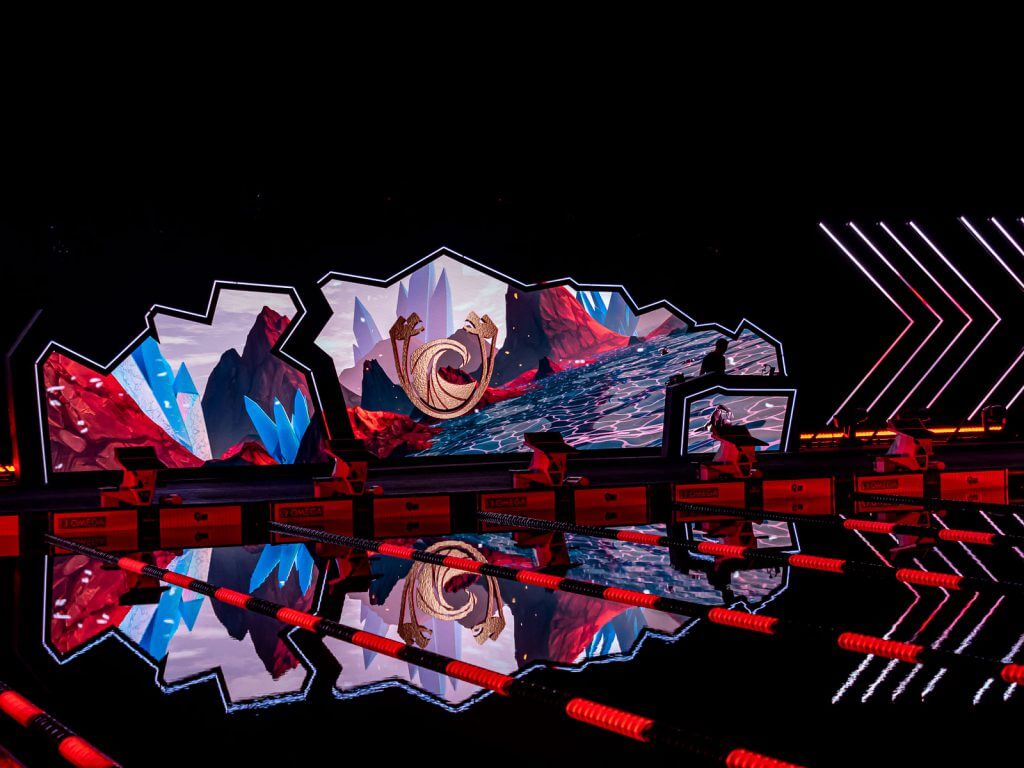
The Swim League
Editorial
Great lights, logos, suits and setting; fine racing. None of that is enough. It’s early days.
Even so, let’s be clear: given all the potential of the International Swimming League to transform the sport and the lives, lifestyles and livelihoods of athletes and other players, there is no point at this juncture in swimming history on focusing only on the good stuff.
The athlete who walks out of a race with gold needs no more than a broad smile and a pat on the back at that moment. Job done. That’s the bit where the League, with its season and twixt-Olympics showcase, gets off the ground; where the athletes, coaches, managers and teams set off on a pro-journey with an event organiser committed from the outset to a 50:50 share of revenues.
Fourth place, eighth home, below best: these are the disappointments that need the hours, the art of the mentor, the mindset, the care and careful handling.
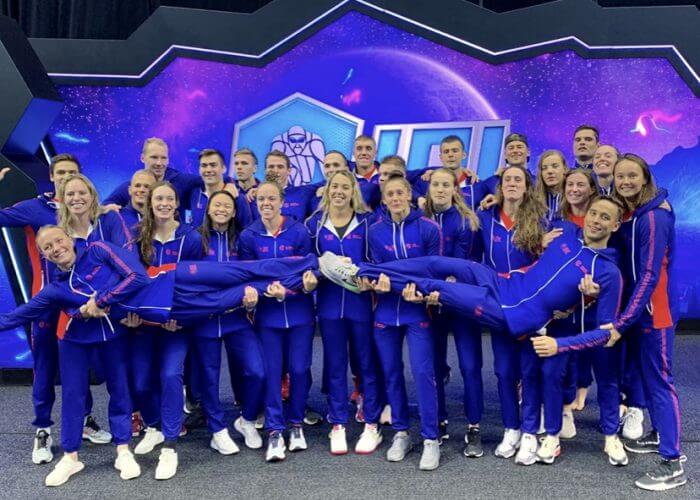
Energy Standard – League round 1 winners in Indy – Photo Courtesy: Energy Standard
These words are written in that spirit. If swimming genuinely wants to grow beyond the solid niche base it has long had, if it wants to draw traditional governance to the athlete-serving place it should have got to long ago, if it wants to make the most of the towering opportunity that athletes – like the Energy winners, pictured, today – and the ISL and their teams have seized the sport must embrace a culture of rapid-debrief/learn-adapt.
That should not be at all difficult in the world of elite sport: just about all involved at the pointy end of ‘Pro’ know what it means to hear ‘you could do better than that’ and receive it not as criticism but as good news: it’s the fuel of motivation for the grit and grind there’s no getting round.
It would not be necessary to write such things if it were not for the fact that review/debrief processes at FINA, if they happen at all, are not transparent, nor do they include the direct or even transmitted voice of vast swathes of the best athletes in the world in any official processes. There is evidence to suggest that the ISL will be quite different. Time will tell.
Day 1 of the League generated a long list for the first debrief. Such outcomes are nothing new. FINA has needed a debrief about the World Cup for at least a decade. It hasn’t had one and the sorry outcome is all too clear, as we note in our Voice For The Sport commentary in Swimming World Magazine this month.
In 2019, they’re reaching the wall in a final at something called ‘World Cup’ in times slower than Shane Gould 1972; Jim Montgomery 1976; Mark Spitz 1972 … and so on and so forth. And that at a showcase with money sloshing about and aimed at fulfilling FINA’s constitutional duty to promote and grow the sport of swimming. Not good enough.
Only four men and four women in Budapest for the FINA event made the 900-point performance level (1,000 is the world record – and 900 is slow-lane stuff on the biggest of occasions). Yes, there were three Dutch breaststroke records for Arno Kamminga and very speedy sprints from Vladimir Morozov.
Two swallows do not a summer make, so to speak, even in a sport of no seasons discernible to the outside world. The swimming calendar is a catastrophe.
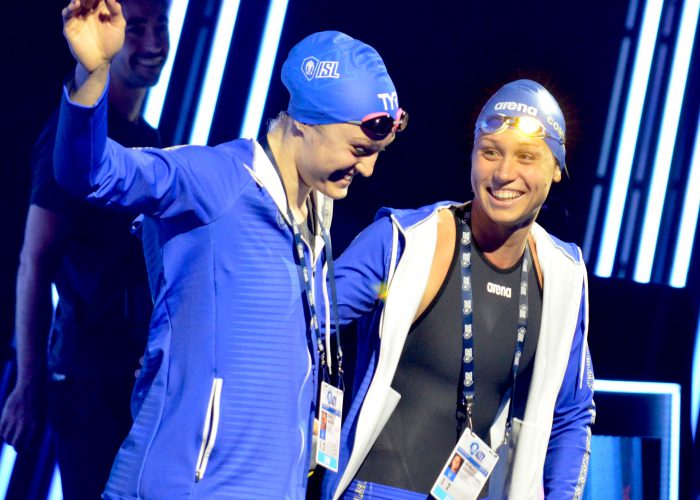
Cali Condors Kelsi Dahlia and Mallory Comerford learning to fly on the ISL deck – Photo Courtesy: Dan D’Addona
Then there’s the devotion to long hours of heats that few, even among fans, tune into or care about; the ball-and-chain of an all-but eight-day World Championship program squeezed into two days, wave after wave of what is far too often mediocrity, relative and real. Such things leave swimming looking like a tug past sell-by date yet still battling against the tide of a challenging and competitive trillion-dollar sports industry.
Don’t misunderstand: love the Olympics, love the World Championships. Their programs don’t need to ruin family lives at eternal meets with heats and semis and finals and achingly long long weekends, especially when the rest of the world couldn’t give a damn.
If swimming is to preserve all of that, then bring back Trudgeon and tell Peaty the pioneer he’s got it all wrong.
On the other hand … of all sports, swimming knows best what it feels like to travel with the tide, to keep up with the wave.
The League is a league ahead of that woeful World Cup state of affairs, on a different track entirely, one that has the backing of the best swimmers in the world. And how.
There was plenty of that aforementioned good stuff: the branding, the big bold icons and avatars, the teams and colours and chants and the fast learning: day 1 was lumpy and bumpy; day 2 better, some of the issues ironed out as best the organisers could. The uncertainty of the first day gave way to a touch more confidence on the second. There were improvements in the TV coverage, more passion from swimmers and coaches, it seemed to me as I took on the task of staying home to see what it all looked like as the tight, bright TV show promised.
Where it fell shy is where we need to focus with that debrief in mind – and Pro Athletes will get that. It’s now their job. Alongside the understandable and justified positivity flowing from the swimmers, they must also consider the views of audiences, fans, former swimmers, coaches and others out there commenting in the media, of the traditional kind fed by journalists, and directly on social media.
It is important for athletes, coaches, general managers and all involved with the ISL to stay in tune with the buzz beyond the bubble and bring not only the “just what we’ve been waiting for” to the table but the harder stuff: the cold-light talks of the Monday morning after the first show, the reviews and responses that deliver improvement and progress.
That’s a message FINA’s leadership has never truly shown itself willing to acknowledge, let alone deal with. Another chance for the ISL to show just how different it is.
Here are the issues being raised by the swimming community and beyond on this the first weekend of the global Pro-Team:
BROADCAST – Production and Commentary
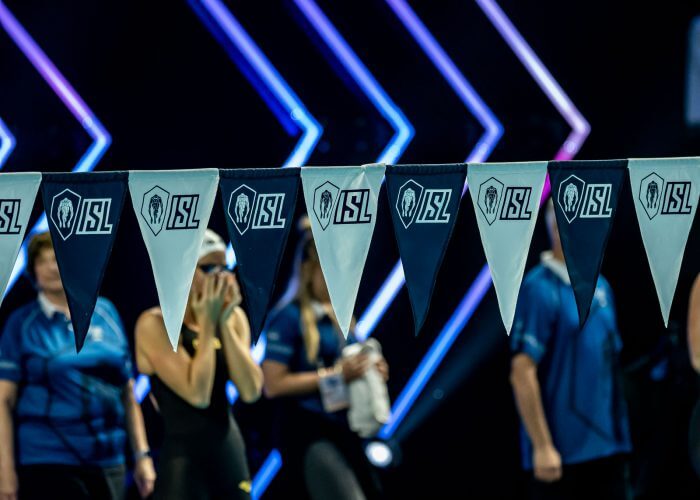
The Swim League stage is set – Photo Courtesy: Peter H. Bick
“The crowd was actually pretty loud at times and all in all I thought they did a pretty good job of being energetic. I think that is a TV issue,” – that was the response of Swimming World‘s Dan D’Addona from the deck in Indy. The question: rare glimpses of the crowd of around 4,000 on the TV coverage prove they’re there but you can’t really hear them or the teams cheering because of the deliberate dampening of background noise by the broadcaster to ensure the clarity of the commentary for home audiences – so, can you confirm there was cheering and the atmosphere was good?
It was, Dan reported. Better camera work on day two brought more confirmation as production turned its gaze to the team pens on the deck, the great backdrops and the fun clearly being had by all As a scribbler not a TV man, I have no idea how you might resolve that one but the atmosphere felt subdued at times on the small screen – and that was a pity and a drawback.
Some viewers/readers suggested that the producers got their camera angles wrong and the commentators were “dreadful”, “awful”, “didn’t know swimming” and so on. The clue to some of that is in the news timeline: It was less than a month ago that rights were finally granted, contracts signed. Preparation for an event that needed testing (thanks, FINA) came down to a matter of weeks when many months, at least, were needed. In defence of the broadcaster: they had to work with a bruising timeline and the challenges that flow from that.
Another watcher/reader summed up many comments when noting (in one of the harshest comments): “The TV production of the actual races was absolutely terrible. There were no splits at all during the races. The only information we got was who was in the lead. You had no idea if swimmers were gaining or losing time during the races (hell, you didn’t even know if they were losing or gaining positions, as apparently that’s not something that could be of any interest to the viewers).
“Just to make things worse the producer came up with the idea to switch to a closeup of the winner as soon as he/she finished, so you had no clue who finished second, third and so on. This is a team competition, so getting a fourth place instead of a fifth could potentially be more important than who wins the race.
“Apparently that’s something the producer had no understanding of whatsoever. This producer actually managed to break things that have worked for as long as swimming have been shown on TV. How are they gonna attract new viewers to the sport when they can’t even get the most basic things right?”
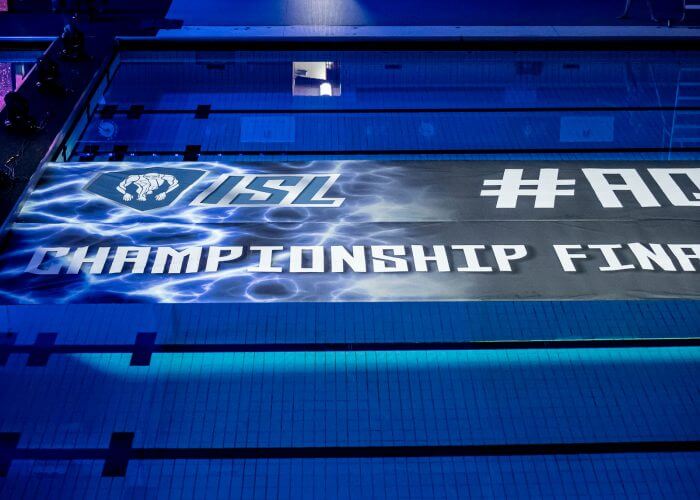
Words on the water at the ISL – Photo Courtesy: Peter H. Bick
THE PROGRAM
Remember that FINA mistake? There is a strong argument for saying the League has started with far more events than it needs on the program. It needs more thought: dragging far too many championship events into a new arena that doesn’t need them makes no sense if the sacrifice for that is that the audience doesn’t hear from swimmers and doesn’t get to learn who they are.
The last time I saw anything at this pace was at the European Sprint Championships win Espoo, Finland, in the early 1990s. I recall then Reuters correspondent Derek Parr sitting next to me and not seeing a single race because his head was stuck in the nitty gritty of a World or European record landing more regularly than planes on a busy day at Heathrow. After a few, Derek simply gave up, kept his head down and tuned in to me saying ‘that’s another one, Derek – event C, time X, swimmer Y, repeat…
Comments:
“Found it really hard to watch. They need to slow the session down and allow the scene to be set. If swimming fans are struggling what chance of attracting others. It is a step forward though.”
“Races are coming thick and fast and almost merging into one another…might have been worthwhile running a test event work out these kinks.”
AUDIENCE IN VENUE AND AT HOME
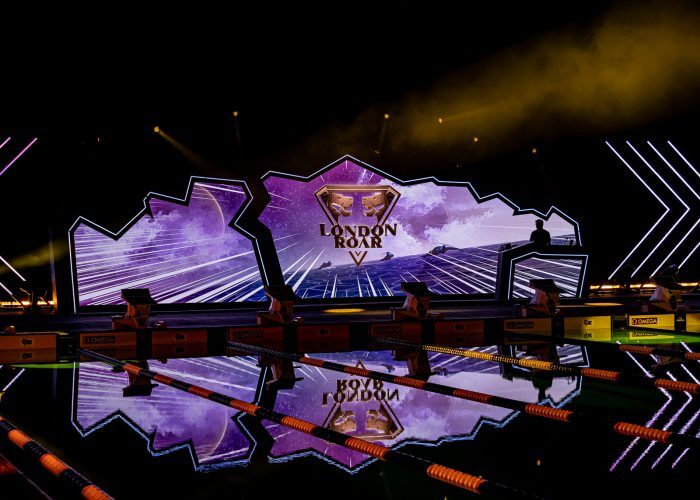
Game-changing at the International Swimming League – Photo Courtesy: Peter H. Bick
There’s a DJ on the deck – but the spinning is just during commercial breaks. There’s nothing actually for the on-site audience to fill the void and the venue goes still. There were not even deckside interviews with managers or swimmers. There were not enough interviews with swimmer in general, to be honest: yes, the swimming speaks volumes but it doesn’t tell a personality.
In the venue (two comments collated): “When the last race was done, you kind of expected some sort of wrap, team cheers, concluding comments. In the venue, on day 1, there was a short interview with Chad Le Clos as teams filed out, no wave goodbye, neither to stand or camera. We’re not talking Qatar and the IAAF but the swimmers simply leaving the building as if they were going home from practice looked a little odd. There was also this: the commentator on site does not really seem to know a lot about swimming, which might get annoying after a while.”
Indeed.
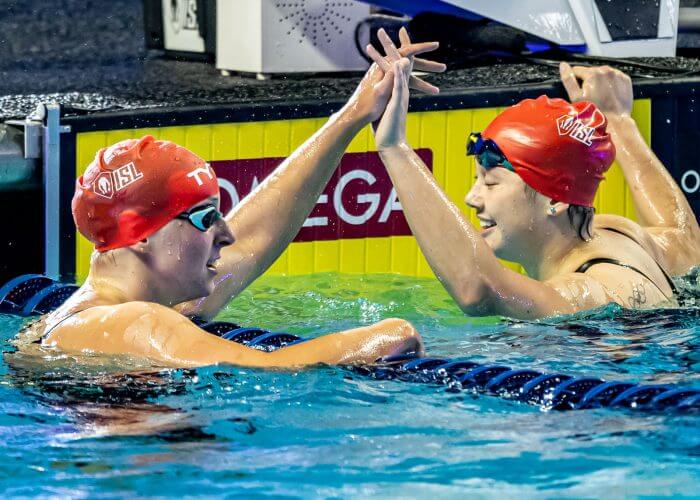
Siobhan Haughey and Katie Ledecky, left, DC Trident teammates – Photo Courtesy: Peter H. Bick
On TV: The show just ended without any conclusion, no interview, no swimmer, nor winning Energy manager nor coach summing up.
The whole show was too tightly packed with action and too little time was devoted to context, talking to teams, explaining why a thing like a 3:54 from Katie Ledecky is worth getting really worked up about.
Worth more than a quick flash of a smile and an ‘awesome’ from a coach caught on camera with no follow-up commentary (because there was no time) to say “You bet it was awesome – and here is why…”.
TV COMMENTARY
Commentators themselves remarked today how fast-moving and packed it all was – so much so that they really didn’t have time to say much of what they might like to have said. Here’s what some TV watchers said:
- “Too fast and not enough time to work out who they swimmers were and what the points were, who belonged to which team…”
- “I turned off because I never got to see the head and shoulders of a swimmer long enough to identify who they were”
- “Heavy graphics were too busy… but that can be an age thing”
- “Poor production on some races, so that when Manaudou won, French Eurosport missed half the pool…”
- No presentation of who the swimmers are, what status, Olympic Champ etc.; no close-ups, no build-up; loss of thrill factor”
- “No athletes quotes and flash quotes, no interviews with swimmers = no personalities”
- “Misses the sell factor of having so many champions but telling no-one who they are or what they have to say”
- “Need cameras in the team bleachers to show cheering and hear the real noise”
- “Am I the only one driven mad with the camera shots? Lane 1 underwater shot at the turn when lanes 6, 7, and 8 are battling for the win. Low angle shot across the pool from lane 1 when all the action was in the top lanes. Over the pool shot from the back 25 showing the middle lanes and cutting off lanes 1 and 8, currently 1st and 2nd on the final length. Also the lack of showing the overall standings during the first hour. I could go on. It was good but it can be a lot better and hopefully it will be.”
- “TV drowns out crowd sound and noise so it felt like the stands were empty and the atmosphere; are the spectators “dead”?
My own observation beyond the above: the setting and the drylands suits/kit looked terrific and there was much excellent use of colour but the caps were too similar, logos too small. Much more can be done to make sure the viewer can identify which swimmer/team is in which lane, both with overlays and physical structures.
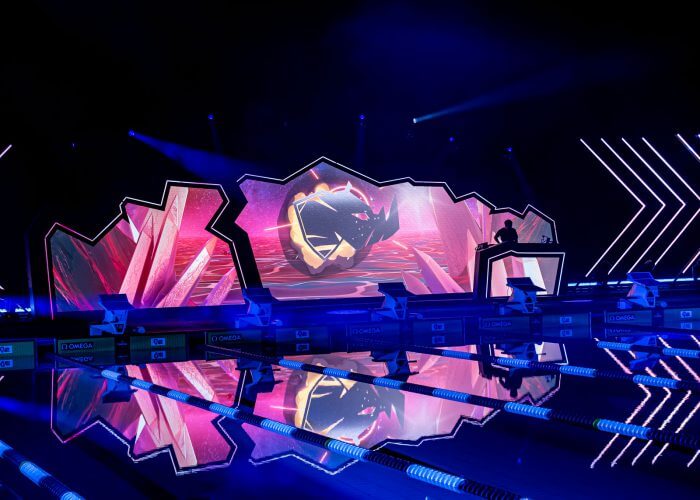
Game-changing at the International Swimming League – Photo Courtesy: Peter H. Bick
SEEDING
Swimming is used to arrowheads. It didn’t get those because teams were allocated the same two lanes each for the duration and the two swimmers from each squad always raced next to each other. That might not produce the best outcome, the pincer sometimes the more thrilling formation but one we won’t see under current format.
Comments:
- “The unusual lane seeding killed the racing and emotion”
- “It needs the best swimmers going head to head in the lanes next to each other”
THE CLOCK
Tick tock. I get that there may well be moments when you can just turn the clock off; have a section of the meet that is just like that. However, the culture of the clock in swimming is old and if you do have a clock on it, best show the result. Many viewers were clearly annoyed that only the winning time – and then only for a few seconds – was displayed at the end of races and no other times were referred to (no scoreboard, no read-out no live timing).
Comments:
- “No splits, no face time with the kids, no results but for the winner and if you blink you miss that. Same with points – there and gone in a flash. Why can’t they keep them on screen?”
POINTS AND PRIZES
A stab at working some of that out on Swimming World DURING live led to all but inevitable error.
In newsrooms at papers the world over, many a writing ego down the years has heard the wise words of a chief sub-editor in reply to please not to touch “a single word”: “If we don’t get it, you can guarantee the reader won’t”.
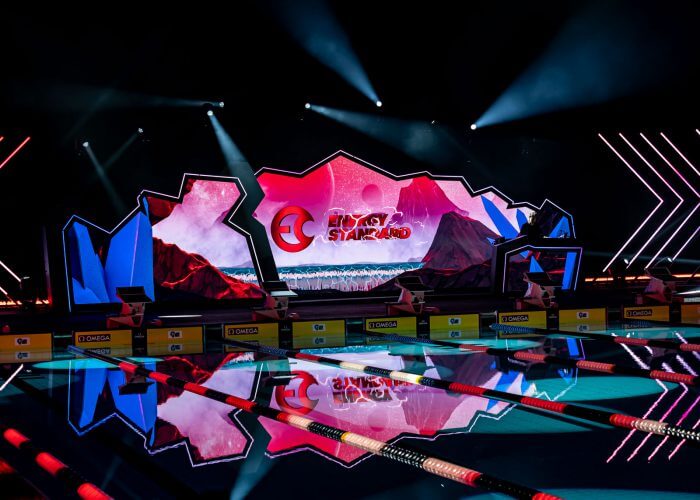
Game-changing at the International Swimming League – Photo Courtesy: Peter H. Bick
The points are too complex. Full stop. The League should decide on what aspect of the points they want to focus on at various stages in the meet and circuit of meets and make that the message for audiences, including the provision of full information. If points make prizes, a list telling me Joe Bloggs has 45 points means… what? I’d like to know – and as soon as possible after the meet ends. What is the monetary worth? And if that can’t be told instantly, then at least make reference to: ‘… swimmer ranks and earning to be published Monday…’ – and make a regular theme of it. More work needed on points and rules in terms of honing in on a simple measure and message to a wider audience that, quite frankly, hasn’t a clue what’s going on. It’s swimming’s job to explain in a way that makes it simple, makes the sport accessible (another reason why the pace is too fast and the absence of swimmer/coach/manager interviews troubling).
THE PRESS
Declaration Of Interest: that’s us.
The League show was designed for TV and the heavy focus on that meant the League overlooked the leaning curve it still needs to travel with the written media as it takes on board a fact about the biggest of Pro-sports, football, tennis, F1, Golf and much else in the mix: the all get it right with broadcasters AND cater for the written press and its very different needs.
At its outset, the League fell shy of being an attractive event as far as attending ‘live’ goes for written media. Why?
For starters:
- No media stands, no dedicated wifi (public services simply not fast enough nor reliable enough for data – photo, results, start lists and other documents – downloads required to do the job in timely fashion), no work room. And not many media – which is no surprise Bec cause it wasn’t marketed to the written press in anything like the timescales required. Budgets, decisions, accreditation, accommodation, travel and much else: all take time and planning – and money. No media is going to drop in on a swim meet at the drop of a hat – or a week or two of notice. Much more planning needed.
- As above, it was often all too fast; the winning time, the points and scores there and gone as you write your next sentence and miss the detail you need.
- No start lists and line-ups until 20 minutes before the start of action on day 1 – much better day 2 (preparation is key to good coverage)
- No access to deckside for photographers; and the lack of stable wifi meant that the job of processing and sending shots had to be carried out away from the venue … so, no instant shots to go live with. This is a point worth making not just for the obvious problem but because it also shows the best side of the ISL as a fledgling organiser: the access issues was raised – and solved within a quarter of an hour. There have been problems at every event I’ve ever attended: the key is ‘how do we resolve it as fast as possible…’, followed by action.
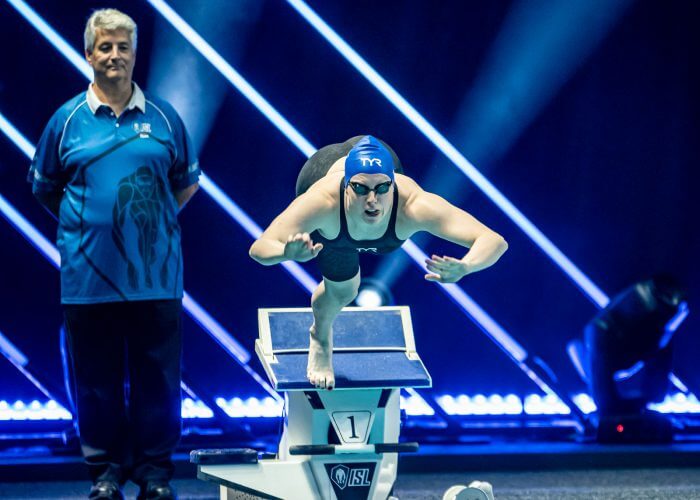
Lilly King – getting a new era off the blocks – Photo Courtesy: Peter H. Bick
THE ATHLETE PERSPECTIVE
“This is unlike any other meet. I think today was kind of a turning point. This is great for swimming and it is only gonna make swimming better for all of us in the years to come – and beyond.” – Katie Ledecky.
“This is really like my kind of meet. Everybody is all hyped up, I had a lot of fun swimming and cheering for my team. I think this is the future of swimming, it is making it more exciting, making it more accessible to the viewer, and it is making the athletes a lot more money. Only positives are coming from this for me,” – Lilly King
“I was so nervous to start the competition. This is what I’ve been waiting for…it was like a World Championship finals, with all of the competitors standing out there behind the blocks.
“This is how it should be … usually when I go to a competition I check my team and then I focus on my next event. But now in between events I was trying to follow my teammates and how they were doing and what the score was. It’s so much fun to watch the other races and support my teammates. I have been waiting for this to happen and I am really happy that it happens during my active years.” – Sarah Sjostrom.
The athletes, rightly, bring their own perspective to the table and have the biggest vested interest in having it all work out. Every quote such as those above and many beyond are justified and valid. There can be no question that this weekend has marked the start of a change in swimming that has been awaited like rain at a time of drought.
Swimmers have, gloriously, woke up to the idea that they have rights and self-determination. The law backs them and they want a say and a fair share. That’s what it took to make FINA wake up – and there’s more awakening to come.
The sport has ISL founder Konstantin Grigorishin and those who helped him for all of that.
But as Grigorishin has said himself, there’s more to it than just turning up to swim (even very fast) and patting each other on the back.
The new Pro world demands a Pro response. Constructive criticism and truth are friends not the enemies that traditional governance has made of them.
Next stop: Naples, a week away.



